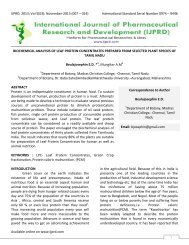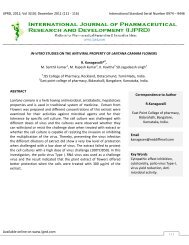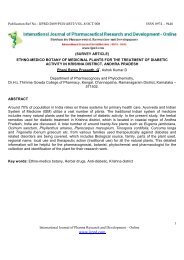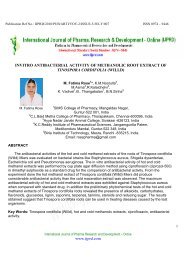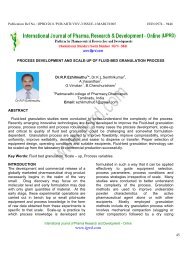a review on phytopharmacological aspects of ficus ... - IJPRD
a review on phytopharmacological aspects of ficus ... - IJPRD
a review on phytopharmacological aspects of ficus ... - IJPRD
Create successful ePaper yourself
Turn your PDF publications into a flip-book with our unique Google optimized e-Paper software.
<strong>IJPRD</strong>, 2011; Vol 4(06): August-2012 (018 – 022) Internati<strong>on</strong>al Standard Serial Number 0974 – 9446<br />
--------------------------------------------------------------------------------------------------------------------------------------------------<br />
A REVIEW ON PHYTOPHARMACOLOGICAL ASPECTS OF FICUS BENGHALENSIS<br />
Available <strong>on</strong>line <strong>on</strong> www.ijprd.com<br />
Shaikh Anis 1* ,<br />
Sameer singh 1 , Mandoria Narendra 1<br />
1 Institute <strong>of</strong> pharmacy, Vikram university, Ujjain<br />
ABSTRACT<br />
With ever increasing momentum in the quest for newer<br />
antimicrobial agents, to counteract the spiralling bacterial drug<br />
resistance, plants are being increasingly explored in many parts <strong>of</strong><br />
the world. Ficus benghalensis, the banyan, is a large and extensive<br />
growing tree <strong>of</strong> the Indian subc<strong>on</strong>tinent. Ficus<br />
benghalensis produces propagating roots which grow downwards<br />
as aerial roots. Once these roots reach the ground, they grow into<br />
woody trunks that can become indistinguishable from the main<br />
trunk.These plants may <strong>of</strong>fer a new source <strong>of</strong> potential activity<br />
against infective microorganisms. Roots <strong>of</strong> Ficus benghalensis<br />
shows antihelmintic activity. The extracts also reported to inhibit<br />
insulinase activity from liver and kidney. F. bengalensis has great<br />
potential as antimicrobial compound against microorganisms and<br />
it can be used for the treatment <strong>of</strong> infectious diseases caused by<br />
resistant microorganisms. This plant has a great medicinal value<br />
as it has been reported to have versatile phytochemical<br />
c<strong>on</strong>stituents including flavanoids. Flav<strong>on</strong>oids showed innvitro<br />
antimicrobial activity against all the bacterial strains.<br />
KEYWORDS antimicrobial, insulinase, antihelmintic, strains.<br />
INTRODUCTION<br />
Ficus benghalensis bel<strong>on</strong>gs to the family Moraceae,<br />
which is comm<strong>on</strong>ly known as Banyan tree. F.<br />
benghalensis are fast growing, evergreen tree<br />
found in m<strong>on</strong>so<strong>on</strong> and rain forests, grow up to 30<br />
meters, with spreading branches and many aerial<br />
roots Leaves, stalked, ovate-corate, 3-nerved<br />
entire, when young downy <strong>on</strong> both sides; petiole<br />
with a broad smooth greasy gland at the apex,<br />
compressed, downy; Fruit in auxiliary paris, the<br />
Corresp<strong>on</strong>dence to Author<br />
Shaikh Anis<br />
Institute <strong>of</strong> pharmacy, Vikram<br />
university, Ujjain<br />
Email: anisshaikh63@gmail.com<br />
size <strong>of</strong> a cherry External features <strong>of</strong> the bark:<br />
Mature bark is 12-18 mm thick,grey, closely<br />
adhered ashy white,light bluish-green or grey<br />
patches, slightly curve, thickness varies with the<br />
age <strong>of</strong> the tree. Surface is deeply fissured and<br />
rough due to the presence <strong>of</strong> l<strong>on</strong>gitudinal and<br />
transverse row <strong>of</strong> lenticles, mostly circular and<br />
prominent, Ficus benghalensis, the banyan, is a<br />
large and extensive growing tree <strong>of</strong> the Indian<br />
subc<strong>on</strong>tinent. Ficus benghalensis produces<br />
18
Internati<strong>on</strong>al Journal <strong>of</strong> Pharmaceutical Research & Development ISSN: 0974 – 9446<br />
propagating roots which grow downwards as aerial<br />
roots. Once these roots reach the ground, they<br />
grow into woody trunks that can become<br />
indistinguishable from the main trunk. Other<br />
names are also known as 'Bengal fig', 'Indian fig',<br />
also bargad, borh, wad, . In Tamil it is known<br />
as aalamaram Sanskrit names include nyagrodha .<br />
This tree is c<strong>on</strong>sidered sacred in India, and <strong>of</strong>ten<br />
shelters a little or larger temple underneath, but is<br />
<strong>of</strong>fered worship <strong>on</strong> its own generally too, and<br />
especially so <strong>on</strong> <strong>on</strong>e particular full mo<strong>on</strong> day in<br />
summer when the full mo<strong>on</strong> occurs near the last<br />
star <strong>of</strong> the c<strong>on</strong>stellati<strong>on</strong> Scorpio but definitely<br />
before beginning <strong>of</strong> Sagittarius. Even apart from<br />
the worship, it is <strong>on</strong>e <strong>of</strong> the most sheltering trees in<br />
the heat <strong>of</strong> the land, with a large and deep shade,<br />
and is thus extremely useful for travellers <strong>of</strong> the old<br />
sort - <strong>on</strong> foot, bicycles or oxcarts, or horse riders -<br />
travelling for hours or days; traditi<strong>on</strong>ally it was<br />
found almost ubiquitously <strong>on</strong> roads and in village<br />
centres, the latter very useful for any formal or<br />
informal gathering to be c<strong>on</strong>ducted in a cool place<br />
or even for any poor pers<strong>on</strong> or a traveller to sleep<br />
underThe respect for this and other trees <strong>of</strong> this<br />
nature is thus linked both to the use and the<br />
Available <strong>on</strong>line <strong>on</strong> www.ijprd.com<br />
worship as sacred. Also known asIndian<br />
Banyan, Ficus bengalensis is also the Nati<strong>on</strong>al<br />
tree <strong>of</strong> India. The Great Banyan in the Indian<br />
Botanic Garden, Howrah, is c<strong>on</strong>sidered to be <strong>on</strong>e <strong>of</strong><br />
the largest trees in the world in terms <strong>of</strong> area<br />
covered. Two other well known large trees <strong>of</strong> this<br />
species are <strong>on</strong>e in Uttar Pradesh near Varanasi and<br />
another in Karnataka near Bangalore. The<br />
circumference <strong>of</strong> the whole complex <strong>of</strong> trees<br />
grown from the <strong>on</strong>e central ancestor - still very<br />
much alive and all c<strong>on</strong>nected to it by the roots<br />
visible well over human height - is measured in<br />
kilometers. On the banks <strong>of</strong> the Narmada stood a<br />
celebrated specimen, supposed to be that<br />
described by Nearchus, the admiral <strong>of</strong> Alexander<br />
the Great. This tree <strong>on</strong>ce covered an area so<br />
immense, that it was known to shelter no fewer<br />
than 7000 men, and though much reduced in size<br />
by the destructive power <strong>of</strong> floods, the remainder<br />
was described by James Forbes in his Oriental<br />
Memoirsas nearly 2000 ft. in circumference, while<br />
the trunks large and small exceeded 3000 in<br />
number.<br />
The figs are eaten by birds and mammals. Fig seeds are dispersed by birds such as the Indian Mynas and<br />
studies have shown that seeds that pass through the digestive system <strong>of</strong> the bird are more likely to germinate<br />
as well as sprout earlier.<br />
19
Internati<strong>on</strong>al Journal <strong>of</strong> Pharmaceutical Research & Development ISSN: 0974 – 9446<br />
Scientific classificati<strong>on</strong><br />
Kingdom: Plantae<br />
(unranked): Angiosperms<br />
(unranked): Eudicots<br />
(unranked): Rosids<br />
Order: Rosales<br />
Family: Moraceae<br />
Genus: Ficus<br />
Species: F. benghalensis<br />
Binomial name<br />
Ficus benghalensis<br />
L.<br />
Syn<strong>on</strong>yms<br />
Ficus indica L.<br />
Chemical c<strong>on</strong>stituents <strong>of</strong> the plant studied<br />
Preliminary phytochemical investigati<strong>on</strong> <strong>of</strong> root <strong>of</strong><br />
F. benghalensis showed the presence <strong>of</strong><br />
carbohydrates, flav<strong>on</strong>oids, amino acids/ proteins,<br />
steroids, sap<strong>on</strong>ins and Tannins [23]. The bark <strong>of</strong> the<br />
Ficus benghalensis c<strong>on</strong>tains leucopelarg<strong>on</strong>idin -3-0x-L<br />
rhamnoside and leuco cynidin. 3-0-x-D<br />
galactosyl cellobioside, glucoside beta glucoside,<br />
20-tetratria c<strong>on</strong>thene-2- <strong>on</strong>e, 6- hepatatria<br />
c<strong>on</strong>tene-10-<strong>on</strong>e, pentatricentan<br />
Ethnobotany <strong>of</strong> the plant studied.<br />
Roots <strong>of</strong> Ficus benghalensis shows antihelmintic<br />
activity. The extracts also reported to inhibit<br />
insulinase activity from liver and kidney. Fruit<br />
extracts exhibits anti-tumour activity. [26].The fruit<br />
extracts <strong>of</strong> Ficus benghalensis exhibit antitumor<br />
activity and antibacterial activity, but no antifungal<br />
activity Ficus benghalensis used in Ayurveda for<br />
treatment <strong>of</strong> diarrhea, piles, teeth and skin<br />
disorders. . The bark is used in inflammati<strong>on</strong>,<br />
swelling at neck, g<strong>on</strong>orrhea, scabies mouthwash<br />
for tooth ache, and for strengthening gums, and<br />
steeped freshly burnt bark has been said to cure<br />
cases <strong>of</strong> obstinate hiccup.<br />
Antibacterial activity <strong>of</strong> Ficus benghalensis In<br />
2007, aqueous and ethanolic extracts <strong>of</strong><br />
F.benghalensis were investigated for antibacterial<br />
activity against Pseudom<strong>on</strong>as aeruginosa, Proteus<br />
mirabilis,Stapylococcus aureus, Bacillus cereus,<br />
Alcaligenesfaecalis and Salm<strong>on</strong>ella typhimorium.<br />
The ethanolic extract showed c<strong>on</strong>siderable<br />
Available <strong>on</strong>line <strong>on</strong> www.ijprd.com<br />
antibacterial activity against Pseudom<strong>on</strong>as<br />
aeruginosa, Proteus mirabilis and Bacillus cereus. It<br />
also showed certain antibacterial effects against A.<br />
faecalis and S. typhimorium but it was inactive<br />
against S. aureus. Aqueous extract <strong>of</strong> F. bengalensis<br />
hit was c<strong>on</strong>cluded that ethanolic extract <strong>of</strong> F.<br />
bengalensis has great potential as antimicrobial<br />
compound against microorganisms and it can be<br />
used for the treatment <strong>of</strong> infectious diseases<br />
caused by resistant microorganisms . Actinomyces<br />
viscosus bel<strong>on</strong>gs to group <strong>of</strong> Actinomycetes. It is<br />
gram positive, aerobic, n<strong>on</strong> sporing rod shaped<br />
bacteria. It is frequently encountered in high<br />
proporti<strong>on</strong> <strong>of</strong> smooth tooth surface and gingiva.<br />
Various experiments were performed to check the<br />
antibacterial activity <strong>of</strong> F. bengalensis against A.<br />
viscosus.<br />
Antimicrobial activity <strong>of</strong> Flav<strong>on</strong>oids<br />
Flav<strong>on</strong>es are phenolic structures c<strong>on</strong>taining <strong>on</strong>e<br />
carb<strong>on</strong>yl group (as opposed to the two carb<strong>on</strong>yls in<br />
quin<strong>on</strong>es). The additi<strong>on</strong> <strong>of</strong> a 3-hydroxyl group<br />
yields a flav<strong>on</strong>ol [30]. Flav<strong>on</strong>oids are also<br />
hydroxylated phenolic substances but occur as a<br />
C6-C3 unit linked to an aromatic ring. Since they<br />
are known to be synthesized by plants in resp<strong>on</strong>se<br />
to microbial infecti<strong>on</strong> [ 31]), it should not be<br />
surprising that they have been found in vitro to be<br />
effective antimicrobial substances against a wide<br />
array <strong>of</strong> microorganisms. Their activity is probably<br />
due to their ability to complex with extracellular<br />
and soluble proteins and to complex with bacterial<br />
20
Internati<strong>on</strong>al Journal <strong>of</strong> Pharmaceutical Research & Development ISSN: 0974 – 9446<br />
cell walls, as described above for quin<strong>on</strong>es. More<br />
lipophilic flav<strong>on</strong>oids may also disrupt microbial<br />
membranes Catechins, the most reduced form <strong>of</strong><br />
the C3 unit in flav<strong>on</strong>oid compounds, deserve<br />
special menti<strong>on</strong>. These flav<strong>on</strong>oids have been<br />
extensively researched due to their occurrence in<br />
ool<strong>on</strong>g green teas. It was noticed some time ago<br />
that teas exerted antimicrobial activity and that<br />
they c<strong>on</strong>tain a mixture <strong>of</strong> catechin compounds.<br />
These compounds inhibited in vitro Vibrio cholerae<br />
O1, Streptococcus mutans, Shigella and other<br />
bacteria and microorganisms. The catechins<br />
inactivated cholera toxin in Vibrio and inhibited<br />
isolated bacterial<br />
DISCUSSION<br />
With ever increasing momentum in the quest for<br />
newer antimicrobial agents, to counteract the<br />
spiralling bacterial drug resistance, plants are being<br />
increasingly explored in many parts <strong>of</strong> the world.<br />
These plants may <strong>of</strong>fer a new source <strong>of</strong> potential<br />
activity against infective microorganisms We<br />
studied the antibacterial properties <strong>of</strong> flav<strong>on</strong>oid<br />
extract <strong>of</strong> Ficus benghalensis. This study shows<br />
F.benghalensis has significant antibacterial activity<br />
against most <strong>of</strong> the tested bacterial pathogens. Of<br />
these S.aureus and P.aeruginosa are important<br />
human pathogens with known potential for drug<br />
resistance. P.vulgaris is again important multi-drug<br />
resistant pathogen with potential for producing<br />
metallo β-lactamases and extended spectrum β<br />
lactamases .The MIC for Proteus vulgaris and<br />
Bacillus subtilis were extremely low followed by<br />
Pseudom<strong>on</strong>s aeruginosa and E.coli .The MIC <strong>of</strong><br />
S.aureus was little high compared to other gram<br />
negative bacteria. The number <strong>of</strong> flav<strong>on</strong>oids inhibit<br />
the growth <strong>of</strong> E.coli and Plasmodium falciparum<br />
invivo by targeting specific enzymes <strong>of</strong> fattyacid<br />
biosynthesis.<br />
CONCLUSION<br />
This article comprised <strong>of</strong> plant descripti<strong>on</strong>,<br />
phytochemical c<strong>on</strong>stituti<strong>on</strong>, total flavanoid<br />
c<strong>on</strong>tent, antibacterial activity (disc diffusi<strong>on</strong> assay,<br />
minimum inhibitory c<strong>on</strong>centrati<strong>on</strong>) <strong>of</strong> Ficus<br />
benghalensis Linn. (moraceae), a medicinal plant<br />
Available <strong>on</strong>line <strong>on</strong> www.ijprd.com<br />
found throught India and also in Bengal. This plant<br />
has a great medicinal value as it has been reported<br />
to have versatile phytochemical c<strong>on</strong>stituents<br />
including flavanoids. Flav<strong>on</strong>oids showed innvitro<br />
antimicrobial activity against all the bacterial<br />
strains.This is the evaluti<strong>on</strong> <strong>of</strong> the activity <strong>of</strong><br />
flav<strong>on</strong>oids against β-lactamase producing<br />
Staphylococcus aureus At present,<br />
flav<strong>on</strong>oidc<strong>on</strong>taining preparati<strong>on</strong>s are also<br />
produced for the treatment <strong>of</strong> stomach and<br />
duodenum disorders , as well as glaucoma,<br />
hemorrhagic retinopathy, and thyroid gland<br />
hyperfuncti<strong>on</strong> [49].Thus, flav<strong>on</strong>oids may be<br />
c<strong>on</strong>sidered potential therapeutic compounds for<br />
infecti<strong>on</strong>s that may be caused by these pathogenic<br />
bacteria in the future. Therefore, further work is<br />
underway to identify the bioactive compound.<br />
Additi<strong>on</strong>ally, the antimicrobial activity <strong>of</strong> some<br />
antibacterials in combinati<strong>on</strong> with flav<strong>on</strong>oids<br />
against the pathogenic bacteria .<br />
REFERENCES<br />
1. Newman DJ, Cragg GM. Natural products as<br />
sources <strong>of</strong> new drugs over the last 25 years.<br />
J.Nat. Prod., 2007; 70 (3):461.477.<br />
2. Reayi A, Arya.P. Natural Product-like Chemical<br />
Space: Search for Chemical Dissectors <strong>of</strong><br />
Macromolecular Interacti<strong>on</strong>s. Curr. Opin.<br />
3. Chem. Biol. 2005; 9: 240-247.<br />
4. Horborne, JB., William ,CA., Phytochemistry<br />
2000,55, 481.<br />
5. Cushnie, T.P.T., Lamb, A.J., Int. J. Antimicrob.<br />
Agents 2005,26, 343.<br />
6. Galeotti,,F., Barile, E., Curir, P., Dolci, ,M.,<br />
Lanzotti, V., Phytochem. Lett. 1 2008,1, 44.<br />
7. Sathiamoorthy, B., Gupta, P, Kumar,M,<br />
Chaturvedi,A.K, Shukla, P.K, Maurya,R, Bioorg.<br />
Med. Chem. Lett. 17 (2007) 239<br />
8. Alarcón,R, Flores,RC, Ocampos,S, Lucatti,A,<br />
Galleguillo,LF, T<strong>on</strong>n,C, Sosa,V, Planta Med. 74<br />
(2008) 1463<br />
9. Havsteen. B.H. The Biochemistry and medical<br />
significance <strong>of</strong> flavanoids. Pharmacology<br />
therapeutic 2002; 96 : 67-202.<br />
21
Internati<strong>on</strong>al Journal <strong>of</strong> Pharmaceutical Research & Development ISSN: 0974 – 9446<br />
10. Baladrin MF, Kjoke A.J., Wurtele E., et al.,<br />
Natural plant chemicals : sources <strong>of</strong> Industrial<br />
and Mechanical materials science 228:<br />
11. Chisholm, Hugh, ed. (1911). "Fig". Encyclopædia<br />
Britannica (11th ed.). Cambridge University<br />
Press.<br />
Available <strong>on</strong>line <strong>on</strong> www.ijprd.com<br />
*****<br />
12. Midya, S.; R. L. Brahmachary (1991) The Effect<br />
<strong>of</strong> Birds Up<strong>on</strong> Germinati<strong>on</strong> <strong>of</strong> Banyan (Ficus<br />
bengalensis) Seeds. Journal <strong>of</strong> Tropical Ecology.<br />
7(4):537-538.<br />
22



